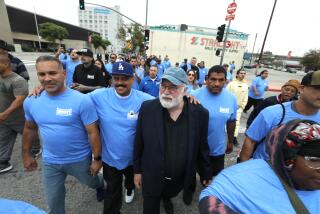Heâs a legend by design
Production designer Robert Boyle may have âretiredâ from the film business some 20 years ago, but the truth is he never really stopped working.
Twice a week, he climbs the stairs leading to his Hollywood Hills home and heads off to the American Film Institute, where he lectures to students about his craft.
By the way, Boyle turns 100 in October.
âIâm a relic of the studio system,â says Boyle, relaxing in the dining room of his rustic home, which, as a trained architect, he designed. Though he uses a cane and has oxygen pumped into his nose, Boyle hasnât lost a step.
And the reason heâs opened his doors for an interview is because the Art Directors Guild Film Society and American Cinematheque are honoring him with a centennial tribute Sunday at the Egyptian Theatre.
In addition to Boyle discussing his craft -- a production designer, originally called an art director, is responsible for coordinating all aspects of a movieâs visual imagery-- with fellow production designers John Muto and Rick Heinrichs, the event will feature two of Boyleâs most imaginative works: 1941âs âThe Wolf Man,â his first film as an art director, and 1969âs âGaily, Gaily,â for which he received an Oscar nomination for his re-creation of 1910 Chicago. His designs for the latter include a huge, opulent bordello that plays a major part in the nostalgic comedy.
âWe should all be so fortunate to have his ability of recall,â says Art Directors Guild President Tom Walsh. âHe is a wonderful testament to the fact that the best narrative designers are constant chameleons. Whatever project they do, they inhabit it.â
Muto says the key to Boyleâs longevity is his resilience. He points out that Boyle had injured himself in 2008 at a party right before he was to receive his honorary Oscar at the Kodak Theatre. âHe was in the wheelchair backstage, but he made a point of hobbling out there with Nicole Kidman. He kept working at it and he got out of the wheelchair. How many people go into wheelchairs at 99 and get out of them? He doesnât give in.â
Boyle began his career in 1933 at Paramount, having just graduated from the University of Southern California with a degree in architecture. Boyle explains that the studioâs art department head Hans Dreier ârecognized the value of the young architectural students in his department. When I first got there they were finishing âThe Scarlet Empressâ with Marlene Dietrich.â
The studio system, he says, was the best teacher for craftsmen like himself. âThe studios were self-contained units and so certain elements of the old system, particularly with the crafts, are now lost,â Boyle laments. âIn those days every studio did everything.â
At Paramount and especially at Universal, where he graduated to art director, Boyle worked on a wide range of movies including horror films such as âThe Wolf Man,â Alfred Hitchcock classics âShadow of a Doubtâ and âSaboteurâ and even the old âMa and Pa Kettleâ comedies.
After working with Hitchcock on those two films, Boyle went into the Army during World War II. âAfter my discharge, I went back to work with Hitch, who had formed a company at RKO with Cary Grant and that didnât pan out. The next opportunity to be with Hitch was he called me for âNorth by Northwestâ and then after that âThe Birdsâ and âMarnie.â â
According to Boyle, once you worked with Hitchcock you became part of his movie family. âHe was a great collaborator,â he says. âHe would discuss a movie with anybody, including his driver.â
Boyle also had a longtime collaboration with director Norman Jewison, which began with 1963âs âThe Thrill of It Allâ and continued through 1968âs âThe Thomas Crown Affair,â âGaily, Gailyâ and 1971âs âFiddler on the Roof,â for which he received another Oscar nomination.
âI still talk to Norman,â he says. âI had a lot of fun working with [him]. He made moviemaking very enjoyable.â
As for teaching at AFI, Boyle says, âI donât know whether I am teaching. I like going on just to be with the young students. This is the only way you can pass [the craft] down.â
Joseph Garrity, who heads the production design discipline at AFI, says that Boyle is the living history of production design. âHe amazes our kids about how things were done back then,â says Garrity. âHe knows all the tricks and in-camera effects. He sometimes comes up with these little words of wisdom the students really appreciate. He is grandpa to all of our fellows.â
--
More to Read
The biggest entertainment stories
Get our big stories about Hollywood, film, television, music, arts, culture and more right in your inbox as soon as they publish.
You may occasionally receive promotional content from the Los Angeles Times.











